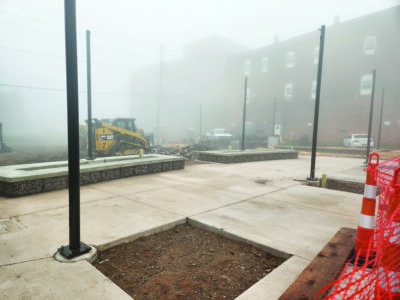Reaching out
SHPO tours Calumet

Graham Jaehnig/Daily Mining Gazette The Calumet Theatre, adjoining the Calumet Village Hall, was originally called the Opera House. With a seating capacity of 1,200, the Opera House was popular, as were the acts that were selected to visit. With the invention of motion pictures and the decline in the copper-mining industry, the opera house was used more for movies than for stage productions. In recent years, it has accommodated a variety of music, theater, and film.
CALUMET – Representatives of the Michigan State Historic Preservation Office (SHPO) were in Calumet last week to host a Historic Tax Credit Workshop. The workshop was conducted during the Historic District Outreach and Networking program held on Thursday at the Red Jacket Ballroom, on Sixth Street.
The two representatives also enjoyed a tour of the Calumet Theatre with Theatre Company President Dan Jamison. Jamison said he offered them the tour because the Calumet Theatre had received a substantial grant from the organization to replace the building’s boiler.
“We (the Theatre Company) wrote the grant on behalf of the village of Calumet so that the village is the owner of the boiler,” Jamison said, “but we paid for it, we got the grant for it and we will maintain it, in keeping with making sure that we’re supporting each other.”
Calumet Village Manager Megan Haselden said the grant was through the Certified Local Government (CLG) Program. The grant, she said, was written on behalf of the village through the CLG, with the Calumet Theatre Company acted as the fiduciary.
Jamison said the SHPO representatives were in Calumet for an event on Thursday, which was to describe the village, describe the prospects, describe the standards and things that we do here, and then they put on an incentive program at the end.”
The Thursday event, billed as the Historic District Outreach and Networking presentation, was hosted by the Calumet Village Historic District Commission (HDC). Haselden said the HDC has wanted to an outreach program for some time.
“This is the first kind of real public engagement outreach that the HDC itself has done,”she said. “Part of the reason for that is our HDC works on a very tiny budget. They are funded through grant through the National Park Service, and then Downtown Development Authority matches that grant, and that primarily makes up all of their funding.”
Haselden said the HDC operates on an annual budget that averages between $,5000 and $6,000. The outreach program, which was free and open to the public, was funded through a CLG grant. “The goal behind it was to inform people about our historic district and the importance of having the district and the value add of owning property in a historic district, so some information for property owners, contractors, architects, realtors, and really just anyone interested in historic preservation,” Haselden said.
SHPO learned of the event, she said, and reached out, saying: “‘Hey, we’re considering doing a historic tax credit workshop.’ So, we partnered to do the outreach event and to follow up with the historic tax credit workshop which is really applicable to anyone who owns a historic property who wants to do work on the property and use those tax incentives to offset some of their expense.”
The CLG Program is administered jointly by SHPO and the National Park Service (NPS). The CLG program provides a framework for promoting, supporting, and enhancing historic preservation activities at the local level. The goal of the CLG, says the NPS, is to facilitate state and local government cooperation to promote nationwide preservation initiatives.
“Through the certification process, local communities make a commitment to national historic preservation standards,” the NPS states. “This commitment is key to America’s ability to preserve, protect, and increase awareness of our unique cultural heritage found across the country.”






